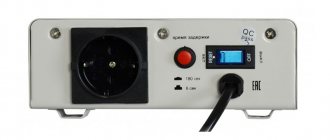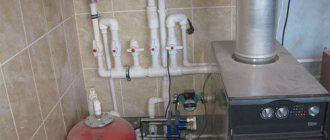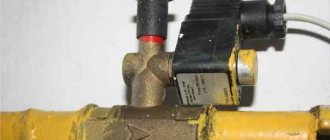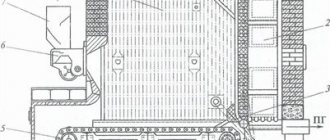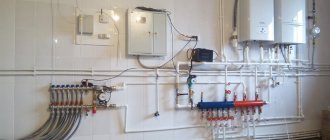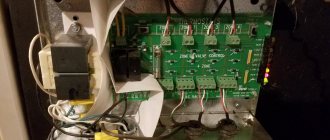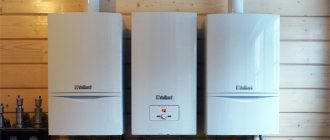A stabilizer for boiler equipment is necessary to protect pumps and automation units from power surges and clean them from frequency distortions. It is used in gardens, country houses, and rural houses where there is instability in the electrical network. The device protects precision equipment responsible for the operation of the heating system from damage. Selection indicators: pump or control unit power taking into account starting currents, error value, overall dimensions.
POWERMAN AVS 500 S – affordable price
Single-phase stabilizer for working with gas boiler equipment with a power of up to 200~300 watts. It is small in size and weight. Made in a wall-mounted version. Equipped with a European output socket. Stabilizes the input parameters of the electric current.
Built-in filters cut off extraneous frequency noise and remove interference. Visual control is carried out on a liquid crystal display. The current state of the structure is reflected by light indicators.
Pros:
- Compact, light weight, fulfills its functions.
- Peak load and short circuit protection.
- Inexpensive, easy to install and connect.
Minuses:
- The socket is at the bottom, slightly inconvenient.
- For some reason there is no second indicator.
Recommendations: 12 best gas boilers
13 best solid fuel boilers
14 best electric boilers
LENZ TECHNIC R500W – accuracy and price
Automated input voltage stabilization device. Used in private homes, medical institutions, office and administrative premises. Built-in protection mechanisms against overheating and overload during intensive work.
The stabilizer has low error and high accuracy of output parameters. It is possible to connect two consumers with a total power not exceeding 500 watts. It neutralizes a wide voltage range and has a 100% power factor.
Pros:
- Compact, accurate, low level of error.
- Bright color LCD screen. Easy connection.
- My two consumers are powered by a gas boiler and a circulation pump.
Minuses:
- Operation in 0.02 seconds, there are better indicators.
Customer Reviews
Maksim
RUCELF BOILER-600 (0.6 kW)
I bought it for a gas boiler. Boiler 600. I was choosing between Calm and Rouself. I decided to support the domestic manufacturer. Everything is fine, the case is steel, powerful, looks good, but the Chinese button that switches the voltage display modes somehow treacherously sticks out half-sidedly onto the floor of the case... I looked, yeah, they sprayed so much paint that the button stupidly doesn’t fit into its place and one of the buttons is already broken out of the fastening tabs, apparently they pushed it - it didn’t fit, they pushed it harder, broke off the tab, well, what the hell with it... Damn it’s a shame! Well. I cut off a drop of paint in the hole, bought a new button, soldered it, installed it... Everything works. It's a small thing, of course, but unpleasant. To immediately disassemble a new thing and, even though it’s such a small thing, still repair it. But overall it works great. There are no complaints about the work.
Pavel Sergeevich
Energy APC 1500
So, the stub was bought for 4300₽ in 2022 for a gas boiler and the ability to connect to it the pump that is in the well. It works with the boiler without problems, I don’t know how accurately it stabilizes, I checked it with a multimeter during drawdowns, it seems to be normal, but you won’t be constantly monitoring it, I looked at it a couple of times and scored. Sometimes when you turn on the boiler, the display blinks strangely, like it turns off and turns on a couple of times, then normal. Sometimes several parts of the numbers disappear on the display. The display is generally useless, 99% of the time it shows the same thing, only occasionally the load changes. Even if the “input” is 180V, it will still show 230V. Next, work in tandem with a pump (about 1 kW, I don’t remember exactly). For some reason, sometimes it goes into overload protection, not always, but about once out of 20. And this is a real problem, because if it goes into protection at night and it doesn’t restart, you need to flip the switch, then by morning it’s already fresh . The heating doesn't work either. There may be a problem with the pump, but directly from the network it works without failures. And if the problem is with the pump, then why 19 times out of 20 it starts normally, with a load of 60-70% (this is paired with the boiler). Krch, it’s not yet very clear why this problem is happening, later I’ll check using a wattmeter (when it arrives) how much the pump (and the stub itself) eats at peak, I’ll add if anything happens.
Maxim R.
Huter 400GS (0.35 kW)
The company already has the same stabilizer, but on the boiler. Works stably. Therefore, when the question arose about power supply for the video surveillance alarm, I suggested that the installers install the same, time-tested one - and received approval. Moreover, it “maintains” the output voltage when the input voltage is from 120 to 260 V - it works in both directions. Stabilization errors are acceptable. Has a couple of output sockets. Does not require care or maintenance. The stabilizer is low-power, but not cheap. But such a device, which produces a stable sine wave at the output, cannot by definition be cheap. Such a miniature stabilizer was purchased for the very specific purpose of providing high-quality power to the gas boiler. The stabilizer copes with this task perfectly. It takes up very little space and hangs on the wall under the boiler.
Alexander
RESANTA ACH-15000/3-EM (15 kW)
The stabilizer was installed in a village house three months ago. Online surges are a common thing in our village; equipment has broken down more than once, both for us and for our neighbors. But now we are calm about the safety of the washing machine, refrigerator and TV. The equipment equalizes the voltage in the network immediately, the voltage indicators are visible on the display. Stabilizer with good efficiency, with functions against short circuit and overheating. The device operates quietly and takes up little space.
Yuri
Calm IS350 (0.3 kW)
I purchased this stabilizer on the recommendation of competent people to protect the wall-mounted Westen Quasar d24fi boiler; the board in these boilers is famous for its demands on the quality of the supply voltage. I bought a stabilizer in the modification for 230 V output voltage, because... The boiler's data sheet indicates exactly this voltage. There are simply no analogues in terms of the speed of response to changes and the accuracy of maintaining the output voltage at this price; Chinese crafts such as all sorts of Svens and Resants have significantly worse performance, a large error in the output voltage, and what is especially important is that Chinese stabilizers do not produce a pure sine wave at the output, there is information on the Internet There are many demonstrative tests with the connection of various stabilizers via LATR to an oscilloscope; the output voltage steps are clearly visible, which is not the case with the Shtil stabilizer. The stabilizer turned out to be unexpectedly very small and light, I expected it to be larger and heavier, there is nothing superfluous - a power button, three signal LEDs and an output socket, a bracket for mounting to the wall is included. The cooling of the stabilizer is passive, it works completely silently, it does not heat up much, it does its job - the boiler does not respond to power surges when the light bulbs begin to flicker. An excellent stabilizer.
Egor Z.
RUCELF BOILER-600 (0.6 kW)
I bought this stabilizer for a small store operating in the private sector. Constant problems with voltage, especially in winter.. I have never regretted buying it. After installation in place, 220V remains stable. Serves two refrigerators, a cash register and a small TV. Basically, I purchased this model because of the inappropriate voltage stabilization range. I've been using this model for about a month now. Overall, I'm happy with everything. The advantages are, firstly, quite high power and stabilization speed. There is no noise during operation. I would also like to note the function of protection against overheating and overvoltage, which is quite convenient and useful. In general, not a bad model.
Shamil
Energy APC 1000
Was purchased for a gas boiler in the village. The boiler installers were unable to connect it due to the impossibility of finding the right plug. Later I had to buy an adapter. You can use a computer cable instead of the standard one. BUT... if you take a cable with an angled plug, you will not be able to use both sockets, because... one plug will interfere with the other, and the switch will be blocked by the cable. What prevented you from installing sockets by rotating them 90 degrees... or using a different type of sockets? Scoreboard. Not the same as the picture in the description. The scoreboard itself is round, three-line. On the middle line, the numbers “220” are constantly lit in large font (a successful marketing ploy); on the top line, in small font, the readings of the power used are displayed. On the bottom line, also in small print, the input voltage is displayed. As I already noted, the display is very bright... the night lights are resting. It looks like the developers listened to marketers who are unfamiliar with the concept of ergonomics. As for the technical side, a conventional relay stabilizer... is no better or worse than others.
Juliana E.
RUCELF BOILER-1200 (1.2 kW)
The stabilizer attracted attention because it was made in Russia, and this, according to my observations, indicates good quality. It turned out to be not only simple to use, but also reliable, especially during voltage surges. The automation is quite sensitive, so having been using the stabilizer for about a year now, I don’t have to worry about the safety of the boiler equipment. During all this time, no interruptions in its work were noticed. I am definitely satisfied with the purchase.
Anton Esyakov
RESANTA ACH-9000/3-EM (9 kW)
The stabilizer was purchased for a garage where equipment powered by a 3-phase circuit is used. And since the voltage in all phases is always low in our life, without a stabilizer some equipment simply refuses to work. A 9 kW voltage stabilizer is quite enough to operate the equipment, since I don’t turn it all on at once anyway.
Pavel L.
Calm IS550 (0.4 kW)
Advantages: Compact, quiet and most importantly the response time to voltage drops is 0 ms. Perfectly smoothes out the consequences of welding work in the same phase and does not lose performance at critically low voltage. I was very pleased with the device’s ability to withstand overloads and return to operating condition without outside intervention, as well as the ability to turn off the load when the voltage limits are exceeded. What is especially valuable in boiler rooms. Disadvantages: There are practically no disadvantages. Comment: I bought it to replace a relay stabilizer, which did not have time to handle sudden voltage drops, as a result, when there was a sharp jump in voltage from low to high, it did not have time to switch and everything burned. The Stihl IS 550 reacts instantly and there are no such problems with it. In my case, it would be convenient to have a second outlet, since the 350 model is enough for one boiler, and the 550 just copes with two boilers, and given the installation in the boiler room, I would like to have an increased level of moisture protection. Otherwise the model is very successful. A little expensive. but it works great. I recommend this model for installation in a dry place with devices that are demanding on network parameters.
Paul
Calm IS350 (0.3 kW)
Advantages: I have not found an analogue in terms of the quality of voltage stabilization within 220V AC and the provision of a sinusoidal voltage curve. In my opinion, this is the best voltage stabilizer in those cases. when it is necessary to provide a high-quality level of stabilization and the shape of a sine wave of alternating current. The device is lightweight, 1550 g, high-quality body and colorful coating correspond in appearance to the highest quality devices of international standard. The light indication clearly indicates the operating mode status of the device, which gives confidence when working with it and understanding the process. Disadvantages: The only, but still disappointing, quality of the output socket of the device. It simply dangles, since its fastening is extremely unreliable. Provided that the socket openings are protected by closing curtains, which are very tight and require strong pressure from the plug of the powered appliance (in my case, an extension cord with several sockets at the end), when connecting it to the socket, the impression is created. that the socket may completely break or fall off. For myself, I decided to plug the extension cord into the outlet once and never take it out again. Comment: I bought the device with a 220V output voltage modification. With continuous fluctuations in the network at the input from 208V to 240V, the output is constantly maintained without any fluctuations, even at least 1V, the voltage of 217V. I took the device to provide reliable power to expensive cinema and audio equipment during the field expedition along the coast of Chukotka, where extremely unstable voltage in the villages is provided by local diesel generators. Weighing just 1.5 kg is the minimum price to pay for reliable power to expensive and critical expedition equipment. The price is not even remotely close to insuring such equipment. I count on the reliability of the stabilizer. While it's working. I can confidently power my equipment and camera battery chargers. This is the only device on the market with this principle and, accordingly, the quality of stabilization - as long as it works.
Oksana Sergeeva
Calm IS550 (0.4 kW)
We spent a long time choosing a stabilizer to protect the Bosch WBN 6000 gas boiler, because... it is very sensitive to voltage changes. On the recommendation of a friend, we began to look at the InStab IS550 inverter stabilizer and, after studying the characteristics, reviews and testimonials, purchased it on the official website. They took it from a representative in Krasnodar. Large stabilization range, absolute noiselessness of the model, which takes up minimal space, being on the wall next to the boiler. I am glad that the stabilizer is of domestic production. Used to protect the boiler and water pump for over a year.
Rucelf BOILER-600 – application in dachas
The design is specially designed to work in tandem with heating equipment in conditions of unstable power grid indicators. Used in rural areas, places with constant voltage fluctuations.
Designed to work with gas boilers, heating equipment control units, circulation pumps, household and electronic appliances. Has a wide input voltage range. Does not distort the sine wave.
Pros:
- Clear operation, works well with a gas boiler.
- Quick installation and connection, affordable price.
- Quiet, durable body.
Minuses:
- Consumers do not note any shortcomings.
Single-phase 220 volts
RESANTA LUX ASN-3000N/1-C
pros
- affordable price
- reliability
- famous brand
- universal
Minuses
- relay, clicking
From 5830 ₽
A good compact UPS will supply high-quality electricity to the voltage-sensitive electronics of gas heating equipment, protecting it from damage and extending its service life. A convenient and easy-to-use device is an ideal purchase for every home.
Calm IS1000
pros
- silent
- backlit display
- wide range of operating voltages
- high-quality assembly
Minuses
- short power cord
From 10490 ₽
The inverter stabilizer is designed to protect gas equipment powered by 220V or 230V. Unlike other types of uninterruptible power supplies, inverter models undergo double conversion of electricity, so the output maintains a stable voltage with an ideal sinusoid. At the same time, the device operates quickly and does not make noise.
DAEWOO DW-TM1kVA – quality and power
Single-phase wall-mounted voltage stabilization device. It is distinguished by high build quality and stable output indicators. The response time does not exceed 20 milliseconds. The total power allows you to connect two consumers, taking into account the magnitude of the starting currents.
Reliability of control is ensured by an electronic unit based on microprocessors. The stabilizer has a low level of its own noise. Provides protection against short circuit, overload and overheating.
Pros:
- High-quality assembly, nice design, powerful.
- Filters, short circuit protection. Doesn't make any noise at all when the voltage isn't floating.
- Bright and large display, easy wall mounting, connection of two consumers.
Minuses:
- The cord is terribly short, and you can’t hang it close to the boiler - it can heat up.
- Beautiful and poorly informative instructions.
Which voltage stabilizer for a boiler is better to buy?
You should first select a voltage stabilizer based on the type of network in the room. Based on this, a single-phase or three-phase option is chosen so that its power is sufficient to suppress power surges. After this, the power of all consumers in the network is assessed so that the stabilizer has this parameter no lower. Two important parameters can complete the selection process - efficiency and percentage of error.
After comparing the leaders of 2022, the following conclusions can be drawn:
- The best-selling model with a low price is Resanta ACH-30000/3-C;
- The best relay voltage stabilizer is Energy APC 1000;
- The best three-phase model for heating boilers is Rucelf SDV-3-15000;
- The best electronic device for current stabilization is Lider PS6W-30;
- The most accurate, powerful and fastest device is Shtil IS3115RT.
It is important to remember that the choice is made strictly according to the available indicators of the electrical network and heating equipment, needs, and budget. And the list of nominees, their characteristics, pros and cons will help you narrow down your search.
RUCELF BOILER-1200 – protection of boiler units
Single-phase stabilizer for reliable provision of boiler heating equipment with stabilized voltage. It is implemented in a wall-mounted version, which allows you to save space and make more efficient use of the room area.
Levels out voltage surges and eliminates impulse noise. Works over a wide input range. It has a high motor life, the internal components are enclosed in a durable and rigid steel body.
Pros:
- Performs basic functions successfully and works in a basement environment.
- Powerful – boiler and circulation boiler connected.
- Durable, rigid case, small in size, mounted on the wall.
Minuses:
- No input fuse.
Energy VOLTRON - 1,000 5% E0101-0154 - power and accuracy
Wall mounted stabilizer. Levels out input distortions of network electricity. It is distinguished by high accuracy and small error coefficient.
Works in tandem with computer and household appliances, heating equipment, control units from the “smart home” series.
It is used in private homes, medical institutions and laboratories, and office premises. Reaction time is less than 10 milliseconds. Works outdoors in any weather.
Pros:
- High-quality assembly, beautiful design, precision.
- Powerful device, good output parameters, small error.
- Small size, LED display.
Minuses:
- Only one output socket.
Double conversion
Calm IS350
pros
- works quietly
- high accuracy
- pure sine wave
- minuscule error.
Minuses
- does not output exactly 220 V
From 4790 ₽
Among inexpensive inverter stabilizers, this model stands out due to its effective protection against short circuits, overheating, network faults and filtering of impulse noise. Made in a stylish modern design, the device is hung on the wall, where it does not interfere with anyone.
RESANTA ACH-600/1-I
pros
- LED indication
- good cooling
- easy installation
- two output sockets
Minuses
- total power 600 W
From 7202 ₽
Today, advanced inverter uninterruptible power supplies are an ideal solution for protecting heating system equipment from high-voltage surges and input voltage sags, frequency fluctuations, harmonic distortion and electrical interference in the supply network. Model ASN-600/1-I, new for 2022, is suitable for a small cottage or apartment with an individual heating system.
Bastion Teplocom ST-555 – super compact design
Small-sized voltage stabilization device. Levels out differences in input parameters of the electrical network. The model is specially designed to protect the heating system and individual components, including gas boilers. Has a remote socket on a flexible cable.
The stabilizer is designed for use in basement conditions with high humidity. Provides protection against lightning strikes.
Pros:
- Super small size, easy to install, lightweight.
- Completely fulfills its duties and is quite accurate.
- Bright LED indication, replaces the night light at night.
Minuses:
- Loud, very good clicks when working.
- The output voltage fluctuates and there is instability in operation.
Criterias of choice
The main criterion for choosing a stabilizer is its type; the operating principle and characteristics of the device, its reliability, the possibility of installation in a boiler room, noise and cost depend on this.
Relay. The simplest and most inexpensive devices. The main element in them is a transformer, the primary winding of which is supplied with incoming power. The secondary winding has from 5 to several dozen circuits (the accuracy of stabilization depends on their number). Depending on the input voltage, the device automatically switches the power to the secondary winding circuit, which will produce a voltage as close as possible to 220 V. The role of the switch is performed by relays (electromechanical switches) enclosed in a sealed housing that prevents open sparking. Relay stabilizers have excellent response speed, are resistant to overloads, have a wide range of input voltage, and due to their simplicity of design, they are wear-resistant and durable, not requiring attention or replacement of working elements. However, even if there are more than 10 secondary winding circuits, they are characterized by large deviations, within 7-10%, which in the case of gas boilers is not critical, because even vulnerable models can easily tolerate voltage deviations of up to 10-15% from 220 V. The only really noticeable drawback is that even modern relays click quite loudly when switching.
Electronic. Also called triac or thyristor, they use triacs or thyristors as switches for switching. In the case of using relays, their number depends on the dimensions of the device; it is impossible to install a large number of relays in a compact case, while compact triacs or thyristors can be installed. The result is a device with a larger number of switching stages, and therefore a more accurate output voltage. Semiconductor switches also mean faster, quieter switching, reliability and durability. However, the price of electronic stabilizers is quite high and using a device costing 6 thousand rubles or more, the functionality of which is aimed only at stabilization, is a controversial decision. Considering that for almost any gas boiler a conventional relay stabilizer will be sufficient.
Inverter. The best option for any application, including connecting a gas boiler. Inverter stabilizers (also known as double conversion) are characterized by maximum accuracy, a pure sine wave, filtered from interference. Without going into unnecessary details, the operating principle of inverter voltage stabilizers is simple:
- At the input, the alternating current of the household electrical network is converted into direct current.
- At the output, direct current passes through the inverter and is converted into alternating current, with a voltage of 220 V and a pure sine wave with a frequency of 50 Hz.
Thanks to double conversion, we always have stable and desired output values, regardless of the voltage parameters and interference in the electrical network at home. Deviations in voltage stabilization in inverter devices reach 1% or less, which is the best result to date.
Minimum required power. Its cost greatly depends on the rated power of the stabilizer, so simply choosing the most productive one and not bothering is not the most justified solution. If you have already decided on the boiler model, just open its operating instructions (or find an electronic copy of it) and see the maximum power consumption. In the instructions, it is usually indicated in the technical characteristics table as rated electrical power (W). The main thing is not to be confused with the thermal power of the boiler (kW). For example, the well-known BAXI ECO-4s 24F consumes up to 130 W; it is also worth considering that starting power (for example, when igniting or starting a pump) can increase instantaneous consumption, up to + 100 W. A certain reserve is also required, we recommend setting aside about 40%, that is, we multiply the indicator by 1.4, total - (130 W + 100 W) * 1.4 = 322 W. Almost all models are characterized by consumption from 100 to 180 W, so for a standard gas boiler you need a 400 W stabilizer that is not particularly strong in power, it will be more than enough. Please note that some models indicate power in Volt-Amps (VA) rather than Watts (W). To convert to Watts, you need to multiply the number in Va by 0.7-0.9 (the value is always different and depends on the power factor (cos φ) of the model). There are also more complex automated boilers with several circulation pumps that consume both 450 and 500 W, but you will definitely know about its increased consumption in advance. If you plan to use more than one circulation pump, you can calculate the required power using the simple calculator below.
Operating voltage range. The optimal values are within 140-260 V at the input. Of course, the wider this range, the more problematic the power supply network the stabilizer will work. If the voltage in the electrical network goes beyond the operating parameters of the stabilizer, the load will be de-energized. And here there is an important point: models that are not equipped with emergency protection can fail if a voltage surge exceeds their limit, and it’s good if they “take the blow” only on themselves. Models equipped with protection will interrupt the power supply without any consequences, and some of them are able to restore power supply automatically. It is also worth considering that the power of most models is greatly reduced when operating at low voltages (120-160 V) and not all manufacturers indicate this.
Reaction time. The decision speed of modern stabilizers is in the range of 4-20 ms. In practice, most boilers do not react in any way to instability for even 20 ms, and some models even to short-term switching on and off from the outlet manually, so the performance parameter is not critically important. However, there are more sensitive models, for which even an 8 ms response will be more than enough. By the way, inverter stabilizers have no response time at all, since their output voltage is absolutely stable and does not depend on the input parameters.
Precision stabilization. Despite the fact that almost all stabilizers show exactly 220 V on the electronic display, the actual voltage may have an error. This “deception” is more likely to ensure that the average, inexperienced user does not worry about indicators, for example, 240 V. Indeed, according to modern standards GOST 29322-2014, a voltage in the range of 207 - 253 V is considered normal. And in practice, gas boilers really work normally within this limit, and most even have instructions stating permissible deviations within +-10% of 230 V. An exception, as in the case of the previous point, can only be ultra-sensitive models, for which it is better to select a stabilizer with accuracy 5% or less. In other cases, modern, even the cheapest, stabilizers allow output deviations of no more than 7-8%.
Other. Finally, there are several important points that also need to be taken into account:
- The method of placing the device can be either wall-mounted or floor-mounted. Of course, for wall-mounted heating boilers, the floor-standing option is not convenient, unless there are free shelves of the required size next to the boiler;
- body material – preferably metal, although not always aesthetically pleasing, but resistant to high temperatures typical of stabilizers;
- We choose exclusively a single-phase device.
Energy ARS-1500 E0101-0109 – optimal for gas boilers
Single-phase stabilizer with high efficiency, up to 98%. It has a small error, no more than 4%. The model is specially designed for use with various heating equipment based on solid, liquid or gaseous fuels.
It has sufficient power to work with the control unit and protect against power surges of the circulation pump. The magnitude of starting currents is taken into account. The response time does not exceed 10 milliseconds.
Pros:
- Power combined with good accuracy.
- Optimal for a gas boiler, connected together with a pump.
- Vertical design, mounted to the wall.
Minuses:
- Massive, difficult to attach to plasterboard walls.
Main types
There are different types of power stabilizers for a gas boiler:
- servo driven They are otherwise called electromechanical. This is the simplest design that has come since the times of the USSR. The operating principle of such a device is to use an autotransformer, along the windings of which carbon brushes move. When the input voltage changes, the position of the brushes changes using a servo drive, which creates a specified voltage of 240 V 50 Hz at the output. Such designs are simple and cheap, but their speed does not allow solving the problem in the required mode. The time difference between the change and the device’s reaction to it allows the boiler electronics to operate in a dangerous mode for moments. Because of this, control boards often burn out, despite the connected stabilizer;
- relay _ The design of these devices resembles the operation of an autotransformer. Its coils are divided into several sections that produce different values. When the power parameters in the network change, a special relay switches sections, adjusting the output value of the device. These stabilizers are relatively inexpensive, but have a large error value (usually 8%) associated with the step type of adjustment. In addition, the speed of relay stabilizers is low, which jeopardizes the delicate electronics of the gas boiler. The advantages of relay devices are considered to be reliability and low maintenance requirements;
- thyristor . These are modified versions of relay stabilizers. The difference is that instead of a relay, the windings are switched at the command of the thyristors. This greatly increases the performance and service life of the device. Such designs can withstand up to a billion switchings without loss of performance. The disadvantages of thyristor devices include the discrete (step) nature of switching, which sets a high error at the output (the same 8%);
- inverter stabilizers . These are the most accurate and high-speed devices. Otherwise they are called double conversion stabilizers. They have a different design. There is no autotransformer, which makes the devices light and compact. The principle of operation has also been changed - the input alternating current is passed through the filter and becomes constant. A certain amount of energy is stored in the capacitor in order to release the charge at the right time to maintain the flow parameters. Then the reverse conversion is carried out into alternating current with a given value. All actions are performed at lightning speed, in a continuous mode. The output values are adjusted smoothly with high precision. The only drawback of the devices is their high cost.
The most effective models are inverter stabilizers, however, all other devices are in demand and are used to work with various equipment.
Shtil R 600T – protection in rural homes
A reliable device for working with high-precision electronic equipment, including microprocessor control units for heating boilers. Has low error, wide input voltage range.
An optimized control algorithm allows you to disconnect consumers during sudden peak loads. There is a mechanism for automatic activation when the extreme values decrease. Two European standard sockets are built-in for connecting protected equipment.
Pros:
- Stable operation, optimal accuracy.
- Small dimensions, wall mounting kit.
- Large input voltage swing.
Minuses:
- Sometimes the lighting flickers, but does not affect the operation of the boiler.
Calm R 800T – high reliability
Wall-mounted single-phase AC voltage stabilizer. Designed to work with heating equipment and heating boilers. Has built-in frequency filters to correct input distortion.
Equipped with LED indication, two European sockets are built-in for connecting to consumers. An electronic protection system and a special algorithm for operating in normal mode and peak loads are used.
Pros:
- High-quality assembly, nothing superfluous, good power.
- Design, informative display.
- Unpretentious, reliable, stable output parameters.
Minuses:
- The display is missing.
- Possibly high price.
Which company's voltage stabilizer is best to choose for a boiler?
A voltage stabilizer is a device with a protective profile, thanks to which pumps and boiler automation units will not fail due to power surges. In addition, it is needed in order to clean up frequency distortions. It can be wall-mounted or floor-mounted and vary in different technical characteristics.
In the search for reliable productivity devices, the best manufacturers were named:
- Bastion is a research and production company from Russia that has been producing modern equipment for power supplies, stabilizers, electrical engineering, protective systems, etc. for about 30 years. One series can contain up to 450 products and models.
- Huter Elektrische Technik GmbH is a German company that was founded in 1979 and entered the domestic market in 2004. Activities are aimed at the development and production of modern electrical equipment that meets international standards. Each product item has a long replacement and service guarantee.
- Energia is a Russian company founded in 2000. Today it is the exclusive distributor of electrical equipment of the large SASSIN corporation. Having its own design department and production sites in China, the range already includes more than 3,000 items, constantly growing.
- Rucelf is a well-known Russian brand that entered the world market more than 10 years ago. The main activity is aimed at the production of household electrical equipment, namely stabilizers, electrical panels and welding equipment, uninterruptible network sources, autotransformers, etc. The high level of products guarantees continuous control of the technological process.
- Powerman is a trademark owned by the trade and industrial group "TAIPIT", founded in 1991. Uninterruptible power supplies (UPS), stabilizers, and batteries are marked with this name. Most of the products are imported abroad.
- APC ( American Power Conversion ) is an American company founded in 1981. Today it is a major supplier of reliable, modern UPS systems, but under a different name. In 2006, the company was acquired, after which it became known as APC by Schneider Electric. The new firm is considered an expert in energy management solutions.
- Sven is a Russian brand founded in 1991. At first it developed and supplied computer peripherals to the market, and then became an affordable and reliable UPS manufacturer.
- Resanta is the largest Latvian manufacturer, which began operations in 1993. Today it is a well-known supplier of heating devices, voltage stabilizers, welding machines and other equipment in the countries of the former CIS.
- Lider is a domestic brand that offers high-quality equipment and AC voltage devices at low prices. In terms of technical characteristics and prices, it is an analogue of the Progress company. Each device is adapted to Russian conditions, has high frost resistance, and can be synchronized with various imported devices.
- Shtil - the company is considered a leader among domestic manufacturers in the production of power supply systems for about 25 years. This is due to our own production base, constant introduction of innovations, and growing scientific potential.
